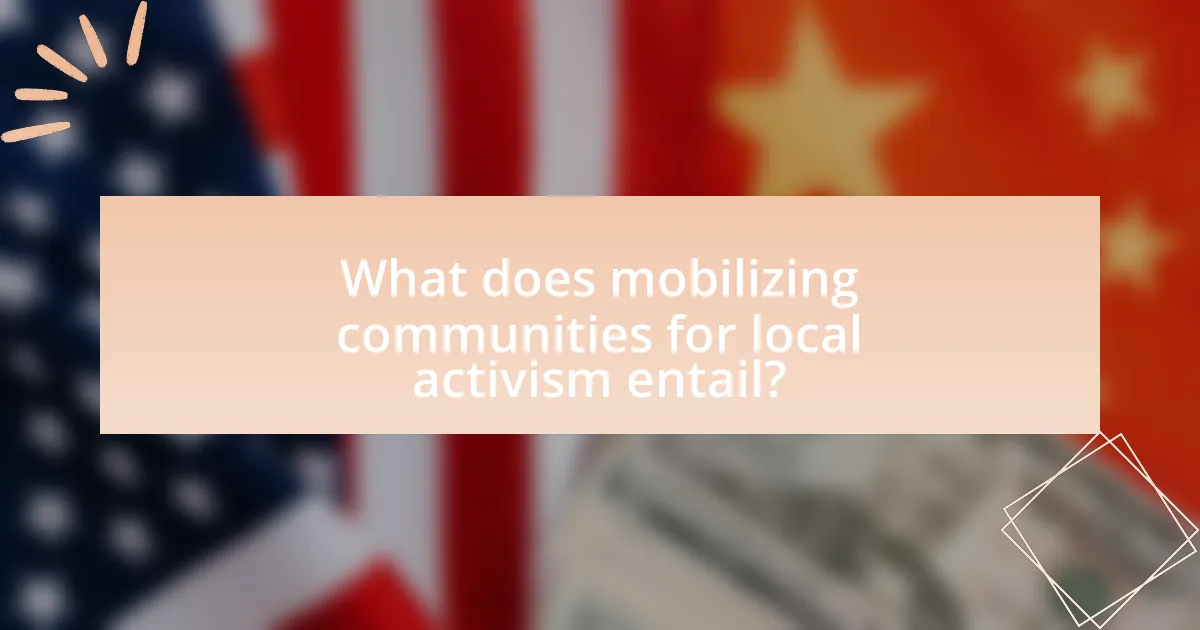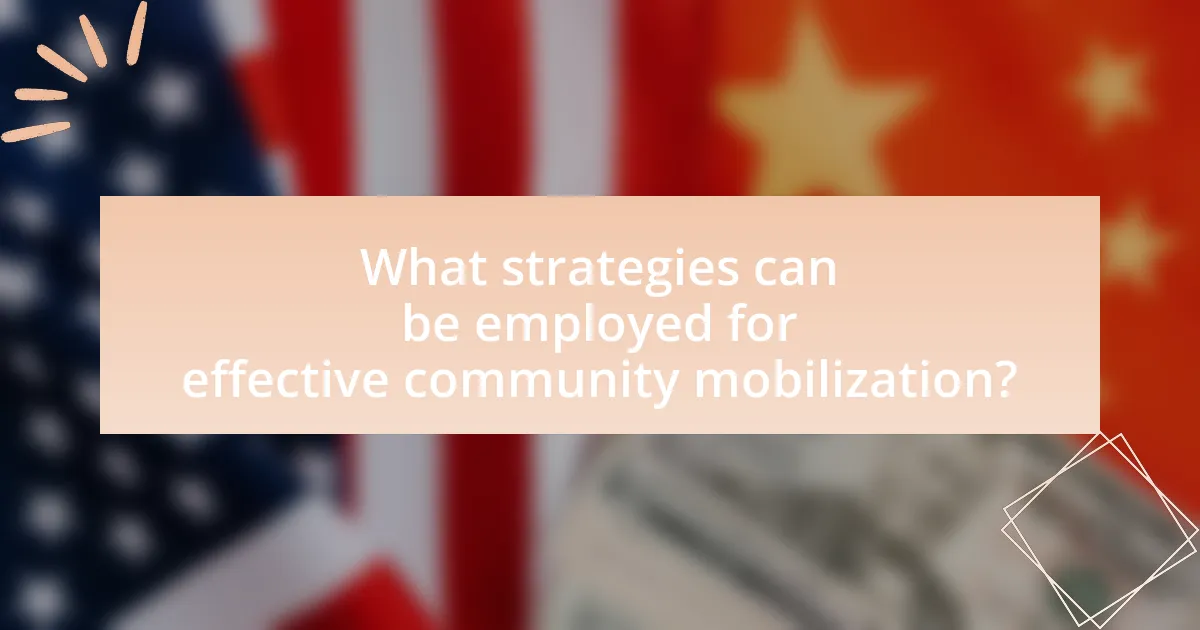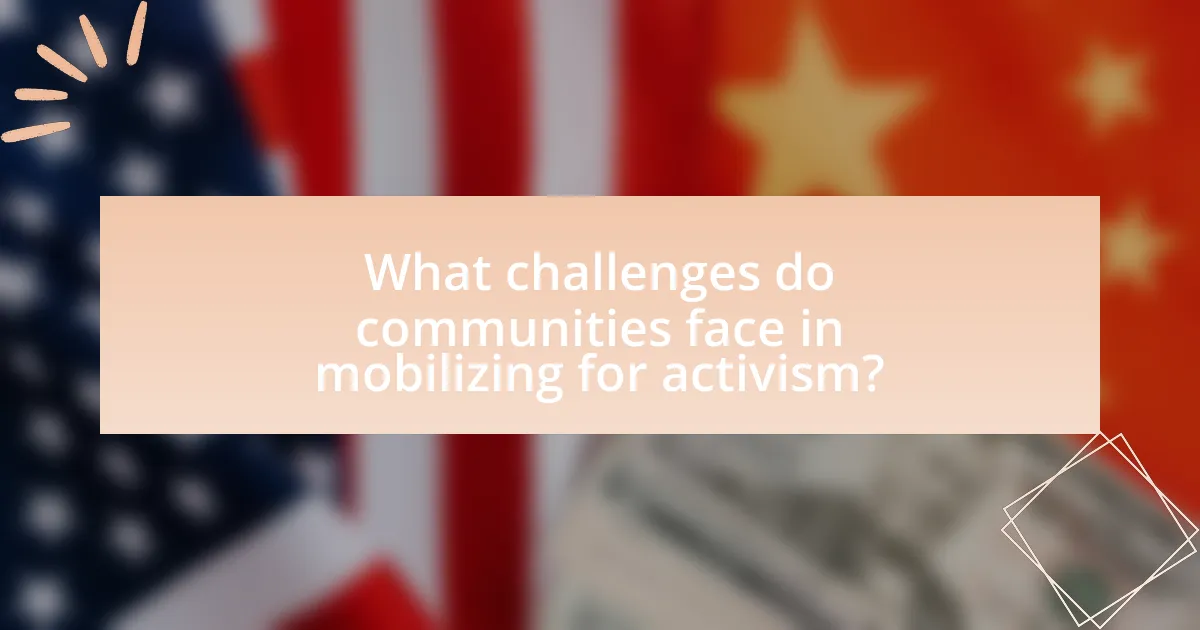Mobilizing communities for local activism involves organizing individuals to engage in collective action addressing local issues through shared concerns and support networks. Key principles include participation, empowerment, sustainability, and collaboration, which enhance civic engagement and advocacy efforts. Effective strategies for mobilization encompass building relationships, utilizing local leaders, and fostering inclusive participation, while challenges such as resource limitations and communication barriers must be addressed. The article explores the impact of community engagement on activism outcomes, the role of grassroots organizing, and the importance of funding and training programs in sustaining local activism initiatives.

What does mobilizing communities for local activism entail?
Mobilizing communities for local activism entails organizing individuals within a community to engage in collective action aimed at addressing local issues. This process involves identifying shared concerns, building networks of support, and facilitating communication among community members to foster participation. Evidence shows that successful mobilization often includes grassroots organizing, where community leaders empower residents through education and resources, leading to increased civic engagement and advocacy efforts. For instance, studies have demonstrated that communities with strong mobilization efforts can significantly influence local policy changes, as seen in various social movements across the United States.
How can community mobilization lead to effective activism?
Community mobilization can lead to effective activism by uniting individuals around shared goals, thereby amplifying their collective voice and influence. When communities come together, they can identify common issues, strategize solutions, and mobilize resources more efficiently. For instance, the Civil Rights Movement in the United States demonstrated how community mobilization, through organized protests and grassroots campaigns, resulted in significant legislative changes, such as the Civil Rights Act of 1964. This historical example illustrates that when communities are mobilized, they can effectively challenge systemic injustices and advocate for their rights, leading to tangible outcomes.
What are the key principles of community mobilization?
The key principles of community mobilization include participation, empowerment, sustainability, and collaboration. Participation ensures that community members are actively involved in decision-making processes, fostering a sense of ownership and commitment to initiatives. Empowerment focuses on enhancing the skills and confidence of individuals, enabling them to advocate for their needs and rights effectively. Sustainability emphasizes the importance of creating lasting change through ongoing support and resources, ensuring that initiatives continue beyond initial funding or interest. Collaboration involves building partnerships among various stakeholders, including local organizations, government entities, and community members, to leverage resources and expertise for greater impact. These principles are supported by successful community mobilization efforts, such as the World Health Organization’s initiatives that highlight the effectiveness of community engagement in health programs.
How does community engagement influence activism outcomes?
Community engagement significantly enhances activism outcomes by fostering collective action and increasing the visibility of issues. When individuals actively participate in their communities, they build networks that amplify their voices and mobilize resources effectively. Research indicates that engaged communities are more likely to achieve policy changes and social justice goals, as seen in the success of grassroots movements like the Civil Rights Movement, where local involvement was crucial for legislative reforms. Furthermore, studies show that communities with high levels of engagement report greater satisfaction with activism efforts, leading to sustained participation and long-term impact.
Why is local activism important for community development?
Local activism is crucial for community development because it empowers residents to address their specific needs and challenges directly. By engaging in local activism, community members can influence decision-making processes, advocate for resources, and foster social cohesion. Research indicates that communities with active local movements often experience improved public services and infrastructure, as seen in the case of neighborhood associations that successfully lobbied for parks and community centers. Furthermore, local activism enhances civic engagement, leading to higher voter turnout and participation in local governance, which are essential for a thriving democratic society.
What role does local activism play in addressing community issues?
Local activism plays a crucial role in addressing community issues by empowering residents to identify problems and advocate for solutions. This grassroots engagement fosters a sense of ownership and responsibility among community members, leading to increased participation in local governance and decision-making processes. For instance, studies have shown that communities with active local organizations experience improved public services and enhanced social cohesion, as evidenced by the success of neighborhood associations in urban areas that have effectively lobbied for better infrastructure and resources.
How can local activism foster social change?
Local activism can foster social change by empowering communities to address specific issues and advocate for their needs. This grassroots approach enables individuals to organize, raise awareness, and influence policy decisions that directly affect their lives. For instance, the Civil Rights Movement in the United States demonstrated how local activism led to significant legislative changes, such as the Civil Rights Act of 1964, which outlawed discrimination based on race, color, religion, sex, or national origin. Additionally, studies show that community-led initiatives often result in more sustainable and relevant solutions, as they are tailored to the unique challenges faced by local populations.

What strategies can be employed for effective community mobilization?
Effective community mobilization can be achieved through strategies such as building strong relationships, utilizing local leaders, and fostering inclusive participation. Building strong relationships involves engaging community members through trust and open communication, which enhances collaboration. Utilizing local leaders leverages their influence and knowledge to inspire action and guide initiatives. Fostering inclusive participation ensures that diverse voices are heard, promoting a sense of ownership and commitment among community members. Research indicates that communities with high levels of engagement and leadership involvement are more successful in mobilization efforts, as evidenced by case studies in community organizing and public health initiatives.
How can grassroots organizing enhance community activism?
Grassroots organizing enhances community activism by fostering local engagement and empowering individuals to take collective action. This approach builds strong networks among community members, enabling them to identify shared issues and mobilize resources effectively. For instance, grassroots movements like the Civil Rights Movement in the 1960s demonstrated how local organizing could lead to significant social change, as communities united to challenge systemic injustices. By providing a platform for voices that are often marginalized, grassroots organizing not only amplifies community concerns but also cultivates leadership skills among participants, leading to sustained activism and advocacy efforts.
What are the steps involved in grassroots organizing?
The steps involved in grassroots organizing include identifying the issue, building a coalition, developing a strategy, mobilizing community members, and evaluating the efforts. First, identifying the issue involves recognizing a specific problem that affects the community. Next, building a coalition requires gathering individuals and organizations that share a common interest in addressing the issue. Developing a strategy entails creating a plan that outlines goals, tactics, and timelines for action. Mobilizing community members involves engaging and encouraging them to participate in activities such as rallies, meetings, or campaigns. Finally, evaluating the efforts assesses the effectiveness of the organizing activities and identifies areas for improvement. These steps are essential for creating impactful grassroots movements that can lead to meaningful change.
How can grassroots movements sustain momentum over time?
Grassroots movements can sustain momentum over time by fostering strong community engagement and maintaining clear communication channels. Engaging community members through regular meetings, social media updates, and collaborative events helps to build a sense of ownership and commitment among participants. For instance, the Black Lives Matter movement has effectively utilized social media to keep supporters informed and mobilized, resulting in sustained activism over several years. Additionally, establishing partnerships with local organizations can amplify resources and outreach, further solidifying the movement’s presence. Research indicates that movements with a clear mission and adaptable strategies are more likely to endure, as seen in the ongoing efforts of environmental groups like Greenpeace, which have evolved their tactics to address changing political landscapes while keeping their core message intact.
What role does communication play in mobilizing communities?
Communication is essential in mobilizing communities as it facilitates the sharing of information, fosters relationships, and encourages collective action. Effective communication strategies, such as community meetings, social media campaigns, and local outreach, enable leaders to inform residents about issues, rally support, and coordinate efforts. For instance, research by the Pew Research Center indicates that 69% of adults in the U.S. use social media, which can be leveraged to mobilize community members quickly and efficiently. This demonstrates that clear and targeted communication not only raises awareness but also empowers individuals to participate actively in community initiatives.
How can social media be leveraged for community activism?
Social media can be leveraged for community activism by facilitating communication, organizing events, and raising awareness about social issues. Platforms like Facebook, Twitter, and Instagram enable activists to share information quickly, mobilize supporters, and create a sense of community among individuals with shared goals. For instance, the #BlackLivesMatter movement effectively utilized Twitter to spread awareness and organize protests, resulting in significant public engagement and policy discussions. Additionally, studies show that social media campaigns can increase participation in local events by up to 50%, demonstrating its effectiveness in mobilizing community action.
What are effective messaging strategies for community mobilization?
Effective messaging strategies for community mobilization include clear, relatable communication, leveraging local narratives, and utilizing multiple channels for outreach. Clear communication ensures that the message is easily understood, while relatable narratives resonate with community members’ experiences and values, fostering a sense of connection. Utilizing multiple channels, such as social media, community meetings, and local events, maximizes reach and engagement. Research indicates that campaigns employing these strategies can increase participation rates by up to 50%, demonstrating their effectiveness in mobilizing communities.

What challenges do communities face in mobilizing for activism?
Communities face several challenges in mobilizing for activism, including lack of resources, insufficient communication, and varying levels of engagement among members. Limited financial resources can hinder the ability to organize events, distribute materials, or reach wider audiences. Additionally, ineffective communication channels may lead to misunderstandings or a lack of awareness about issues and actions, which can diminish participation. Furthermore, differing levels of commitment and interest among community members can create disparities in involvement, making it difficult to achieve a unified front. These challenges are supported by research indicating that resource allocation and effective communication are critical for successful community mobilization (e.g., “Community Mobilization: A Guide for Action,” by the World Health Organization).
How can communities overcome barriers to mobilization?
Communities can overcome barriers to mobilization by fostering inclusive participation and building strong networks. Inclusive participation ensures that diverse voices are heard, which can enhance engagement and commitment among community members. For instance, research by the National Civic League indicates that communities with higher levels of civic engagement are more successful in mobilizing resources and support for local initiatives. Building strong networks facilitates communication and collaboration, allowing community members to share resources and strategies effectively. A study published in the Journal of Community Psychology found that communities with robust social networks are better equipped to mobilize for collective action, demonstrating the importance of connectivity in overcoming mobilization barriers.
What are common obstacles faced during community mobilization efforts?
Common obstacles faced during community mobilization efforts include lack of trust among community members, insufficient resources, and ineffective communication. Lack of trust can hinder collaboration and participation, as individuals may be skeptical of the motives behind mobilization efforts. Insufficient resources, such as funding, manpower, and materials, can limit the scope and impact of initiatives. Ineffective communication can lead to misunderstandings and disengagement, preventing the mobilization from gaining traction. These obstacles are frequently documented in studies on community engagement, highlighting their significance in the success of mobilization efforts.
How can collaboration with local organizations help address these challenges?
Collaboration with local organizations can significantly enhance the effectiveness of addressing community challenges by leveraging their established networks and resources. Local organizations often possess in-depth knowledge of the specific issues faced by the community, enabling targeted interventions. For instance, a study by the National Council of Nonprofits highlights that partnerships between local governments and nonprofits can lead to improved service delivery and resource allocation, ultimately resulting in better outcomes for community members. By working together, these organizations can pool resources, share expertise, and mobilize volunteers, thereby increasing the overall impact of their initiatives.
What resources are available to support community activism?
Resources available to support community activism include nonprofit organizations, funding opportunities, training programs, and online platforms. Nonprofit organizations such as the National Community Reinvestment Coalition provide tools and resources for grassroots activism. Funding opportunities from sources like the Ford Foundation offer grants specifically for community-led initiatives. Training programs, such as those offered by the Center for Community Change, equip activists with skills in organizing and advocacy. Additionally, online platforms like Change.org facilitate petitions and mobilization efforts, allowing activists to reach a broader audience. These resources collectively enhance the capacity of communities to engage in effective activism.
How can funding and grants facilitate local activism initiatives?
Funding and grants can significantly facilitate local activism initiatives by providing essential financial resources that enable grassroots organizations to implement their projects effectively. These financial supports allow activists to cover operational costs, organize events, conduct outreach, and mobilize community members. For instance, a study by the National Committee for Responsive Philanthropy found that targeted funding can increase the capacity of local organizations to engage in advocacy and community organizing, leading to more impactful social change. Additionally, grants often come with networking opportunities and access to training, which can enhance the skills and effectiveness of local activists.
What training programs exist for community organizers?
Training programs for community organizers include the Midwest Academy’s Organizing for Social Change, the National Training Institute for Community Organizing, and the Center for Community Change’s Community Organizing Training. These programs provide essential skills in grassroots mobilization, advocacy, and coalition-building. For instance, the Midwest Academy focuses on strategic planning and campaign development, while the National Training Institute emphasizes practical skills through hands-on workshops. The Center for Community Change offers a comprehensive curriculum that addresses social justice issues and community empowerment, ensuring that participants are well-equipped to lead effective local activism.
What are best practices for sustaining community activism?
Best practices for sustaining community activism include fostering strong relationships, ensuring consistent communication, and providing ongoing education and training. Strong relationships among community members create trust and collaboration, which are essential for long-term engagement. Consistent communication through regular meetings, newsletters, and social media keeps the community informed and motivated. Ongoing education and training empower activists with the skills and knowledge necessary to address issues effectively, as evidenced by studies showing that well-informed activists are more likely to sustain their efforts over time.
How can communities measure the impact of their activism efforts?
Communities can measure the impact of their activism efforts through quantitative and qualitative metrics. Quantitative metrics include tracking changes in policy, attendance at events, or fundraising totals, which provide concrete data on the effectiveness of initiatives. For example, a community that advocates for environmental policy can measure success by the number of new regulations passed or the percentage increase in community recycling rates. Qualitative metrics involve gathering feedback from community members through surveys or interviews to assess changes in awareness, attitudes, and behaviors related to the activism efforts. Research indicates that combining both types of metrics offers a comprehensive view of impact, as seen in studies like “Evaluating Community-Based Health Promotion Programs” by the Centers for Disease Control and Prevention, which emphasizes the importance of mixed-method approaches in assessing community initiatives.
What strategies can ensure long-term engagement in local activism?
To ensure long-term engagement in local activism, building strong community relationships is essential. Engaging local residents through regular communication, collaborative projects, and inclusive decision-making fosters a sense of ownership and commitment. Research indicates that communities with active participation in decision-making processes experience higher levels of sustained engagement, as seen in the study “Community Engagement and Local Governance” by the National Civic League, which highlights that inclusive practices lead to increased trust and participation. Additionally, providing ongoing education and training opportunities empowers activists with the skills needed to address evolving community issues, further solidifying their involvement.